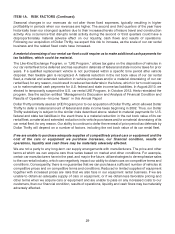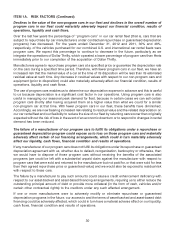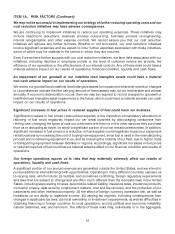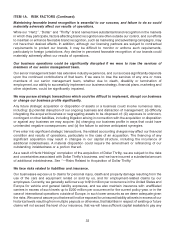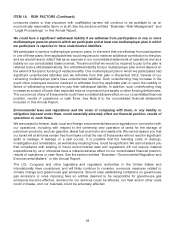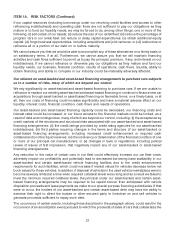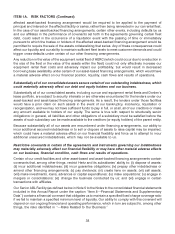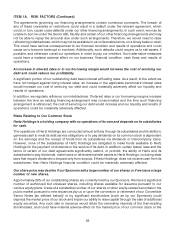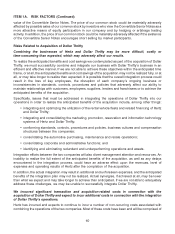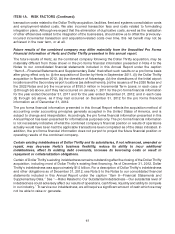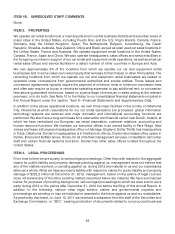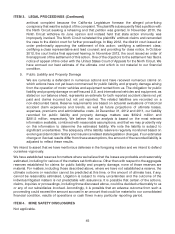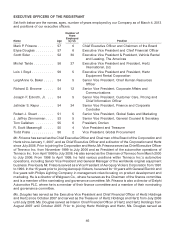Hertz 2012 Annual Report Download - page 62
Download and view the complete annual report
Please find page 62 of the 2012 Hertz annual report below. You can navigate through the pages in the report by either clicking on the pages listed below, or by using the keyword search tool below to find specific information within the annual report.ITEM 1A. RISK FACTORS (Continued)
affected asset-backed financing arrangement would be required to be applied to the payment of
principal and interest on the affected facility or series, rather than being reinvested in our car rental fleet.
In the case of our asset-backed financing arrangements, certain other events, including defaults by us
and our affiliates in the performance of covenants set forth in the agreements governing certain fleet
debt, could result in the occurrence of a liquidation event with the passing of time or immediately
pursuant to which the trustee or holders of the affected asset-backed financing arrangement would be
permitted to require the sale of the assets collateralizing that series. Any of these consequences could
affect our liquidity and our ability to maintain sufficient fleet levels to meet customer demands and could
trigger cross-defaults under certain of our other financing arrangements.
Any reduction in the value of the equipment rental fleet of HERC (which could occur due to a reduction in
the size of the fleet or the value of the assets within the fleet) could not only effectively increase our
equipment rental fleet costs and adversely impact our profitability, but would result in decreased
borrowing base availability under certain of our asset-based financing arrangements, which would have
a material adverse effect on our financial position, liquidity, cash flows and results of operations.
Substantially all of our consolidated assets secure certain of our outstanding indebtedness, which
could materially adversely affect our debt and equity holders and our business.
Substantially all of our consolidated assets, including our car and equipment rental fleets and Donlen’s
lease portfolio, are subject to security interests or are otherwise encumbered for the lenders under our
asset-backed and asset-based financing arrangements. As a result, the lenders under those facilities
would have a prior claim on such assets in the event of our bankruptcy, insolvency, liquidation or
reorganization, and we may not have sufficient funds to pay in full, or at all, all of our creditors or make
any amount available to holders of our equity. The same is true with respect to structurally senior
obligations: in general, all liabilities and other obligations of a subsidiary must be satisfied before the
assets of such subsidiary can be made available to the creditors (or equity holders) of the parent entity.
Because substantially all of our assets are encumbered under financing arrangements, our ability to
incur additional secured indebtedness or to sell or dispose of assets to raise capital may be impaired,
which could have a material adverse effect on our financial flexibility and force us to attempt to incur
additional unsecured indebtedness, which may not be available to us.
Restrictive covenants in certain of the agreements and instruments governing our indebtedness
may materially adversely affect our financial flexibility or may have other material adverse effects
on our business, financial condition, cash flows and results of operations.
Certain of our credit facilities and other asset-based and asset-backed financing arrangements contain
covenants that, among other things, restrict Hertz and its subsidiaries’ ability to: (i) dispose of assets;
(ii) incur additional indebtedness; (iii) incur guarantee obligations; (iv) prepay other indebtedness or
amend other financing arrangements; (v) pay dividends; (vi) create liens on assets; (vii) sell assets;
(viii) make investments, loans, advances or capital expenditures; (ix) make acquisitions; (x) engage in
mergers or consolidations; (xi) change the business conducted by us; and (xii) engage in certain
transactions with affiliates.
Our Senior ABL Facility (as defined below in Note 5 to the Notes to the consolidated financial statements
included in this Annual Report under the caption ‘‘Item 8—Financial Statements and Supplementary
Data’’) contains a financial covenant that obligates us to maintain a specified fixed charge coverage ratio
if we fail to maintain a specified minimum level of liquidity. Our ability to comply with this covenant will
depend on our ongoing financial and operating performance, which in turn are subject to, among other
things, the risks identified in ‘‘—Risks Related to Our Business.’’
38



